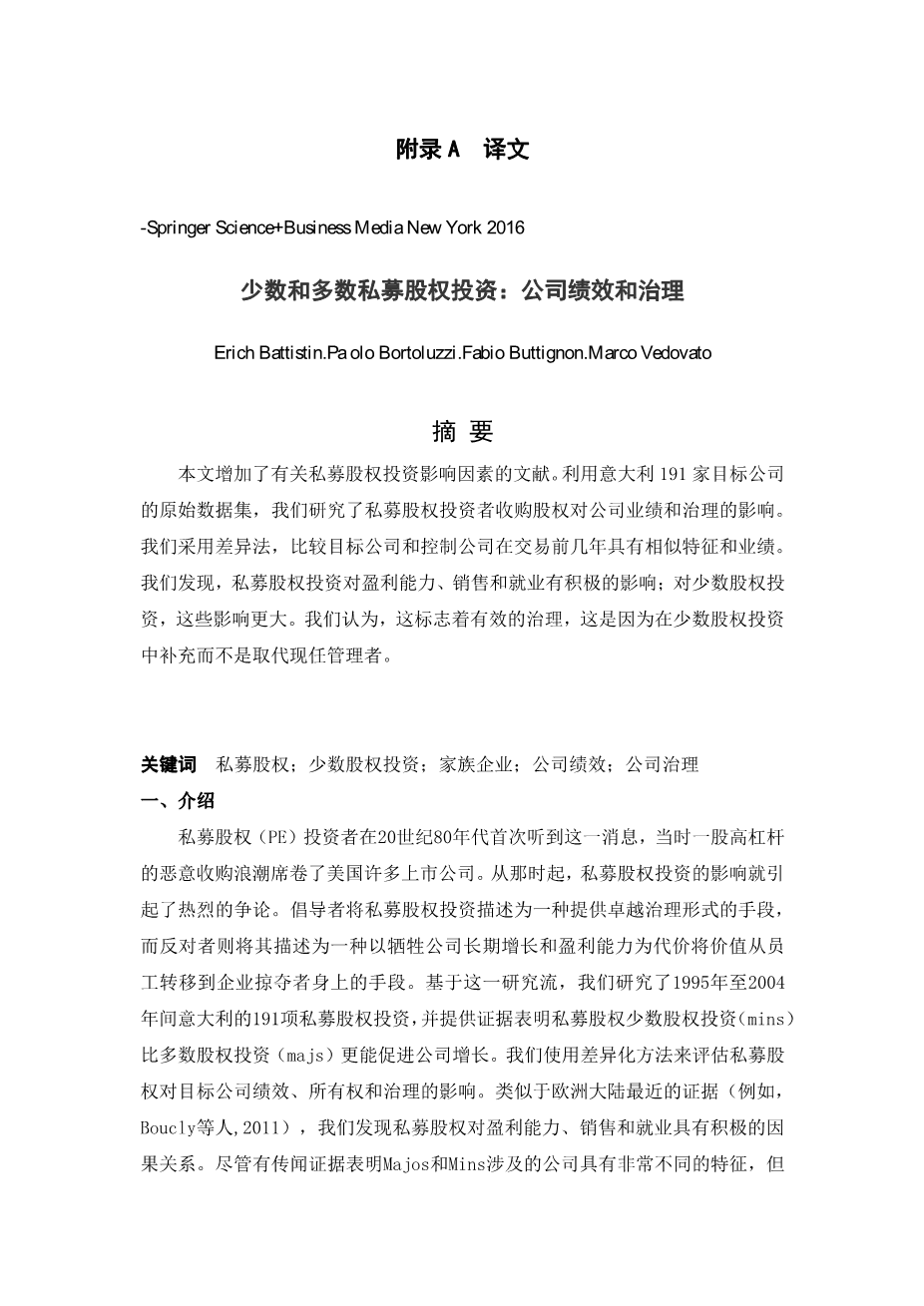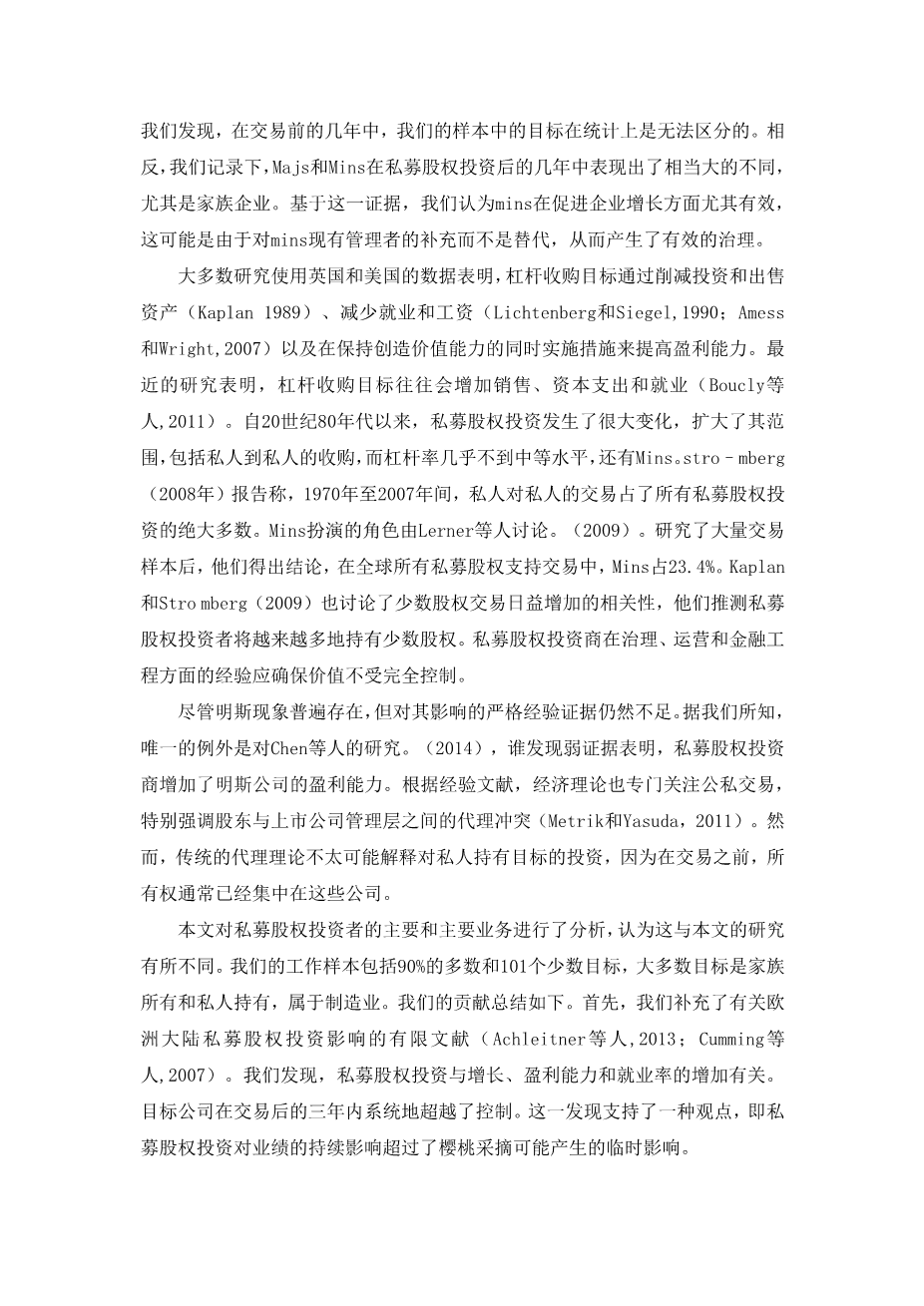外文原文
-Springer Science Business Media New York 2016
Minority and majority private equity investments: firm performance and governance
Erich Battistin.Pa olo Bortoluzzi.Fabio Buttignon.Marco Vedovato
Abstract
This paper adds to the literature on the determinants of the effects of private equity (PE) investments. Using an original dataset of 191 target firms in Italy, we study the effects on performance and governance of the stakes acquired by the PE investor. We employ a difference-in-differences approach and compare target and control firms sharing similar characteristics and performance in the years preceding the deal. We find that PE investment has a positive effect on profitability, sales, and employment; these effects are larger for minority investments. We argue that this signals effective governance that follows from complementing rather than substituting incumbent managers in minority investments.
Keywords Private equity.Minority investment.Family firm.Firm performance .Corporate governance
1 Introduction
Private equity (PE) investors hit the news for the first time in the 1980s when a wave of highly leveraged hostile takeovers took private a number of public companies in the United States. Since then, the effects of PE investments have been lively debated. Advocates describe PE investments as a means to provide a superior form of governance, while opponents depict them as a means to transfer value from employees to corporate raiders at the expense of firmrsquo;s long- term growth and profitability. Building on this stream of research, we study 191 PE investments between 1995 and 2004 in Italy and we provide evidence that PE minority investments (MINs) foster firm growth more than do majority investments (MAJs). We use a differencein- differences approach to evaluate the impact of PE on the performance, ownership, and governance of target firms. Similar to recent evidence for continental Europe (e.g., Boucly et al. 2011), we show that PE has a positive causal effect on profitability, sales, and employment. Despite the anecdotal evidence suggesting that MAJs and MINs involve firms with very different characteristics, we find that targets in our sample are statistically undistinguishable along a large number of observables in the years before the deal. On the contrary, we document that MAJs and MINs show considerably different performances in the years after the PE investment, family firms in particular. Based on this evidence, we argue that MINs are particularly effective in fostering firm growth, possibly as a result of the effective governance that follows from complementing rather than substituting incumbent managers in MINs.
Most studies use UK and US data to show that LBO targets increase profitability by cutting investment and selling assets (Kaplan 1989), reducing employment and wages (Lichtenberg and Siegel 1990; Amess and Wright 2007) and implementing measures to downsize operations while maintaining their ability to create value. Most recent studies show instead that LBO targets tend to increase sales, capital expenditures, and employment (Boucly et al. 2011). PE investments have changed considerably since the 1980s, extending their scope to encompass private-to-private buyouts with little to moderate leverage, as well as MINs. Strouml;mberg (2008) reports that private-to-private transactions account for the vast majority of all PE investments between 1970 and 2007. The role played by MINs is discussed by Lerner et al. (2009). Studying a large sample of deals, they conclude that MINs account for 23.4% of all PE-backed transactions worldwide. The increasing relevance of minority deals is also discussed by Kaplan and Strouml;mberg (2009), who speculate that PE investors will increasingly take minority stakes. The experience gained by PE investors in governance, operational, and financial engineering, should guarantee value without full control.
Notwithstanding the widespread occurrence of MINs, rigorous empirical evidence on their effects remains scant. To the best of our knowledge, the only exception is the study of Chen et al. (2014), who find weak evidence that PE investors increase firm profitability in MINs. In line with the empirical literature, economic theory also has focused exclusively on public-to-private transactions, emphasizing in particular the agency conflicts between shareholders and the management of public firms (Metrick and Yasuda 2011). However, traditional agency theory is unlikely to explain the investment in privately held targets, since ownership is generally already concentrated in these firms prior to the deal.
This paper marks something of a departure from this literature, and considers both MAJs and MINs undertaken by PE investors. Our working sample consists of 90 majority and 101 minority targets that, for the most part, are family owned and privately held and belong to the manufacturing industries. Our contributions can be summarized as follows. First, we add to the limited literature on the effects of PE investments in continental Europe (Achleitner et al. 2013; Cumming et al. 2007). We find that PE investments are associated with increases in growth, profitability, and employment. Targets systematically outperform controls in the three years after the deal. This finding supports the idea that PE investments have persistent effects on performance over and above temporary effects that might result from cherry picking.
Second and most importantly, we show that PE investment effects are larger for MINs, particularly when it comes to profitability and growth.
Finally, we add to the growing body of literature on the drivers of PE investment effects (e.g., Acharya et al. 2013) by exploring the effects on performance of changes to the board of target firms. We show that PE investment
剩余内容已隐藏,支付完成后下载完整资料


英语译文共 10 页,剩余内容已隐藏,支付完成后下载完整资料
资料编号:[609826],资料为PDF文档或Word文档,PDF文档可免费转换为Word
课题毕业论文、文献综述、任务书、外文翻译、程序设计、图纸设计等资料可联系客服协助查找。


